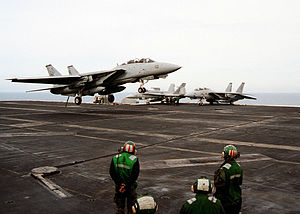
An Arresting gear, or arrestor gear, is a mechanical system used to rapidly decelerate an aircraft as it lands. Arresting gear on aircraft carriers is an essential component of naval aviation, and it is most commonly used on CATOBAR and STOBAR aircraft carriers. Similar systems are also found at land-based airfields for expeditionary or emergency use. Typical systems consist of several steel wire ropes laid across the aircraft landing area, designed to be caught by an aircraft's tailhook. During a normal arrestment, the tailhook engages the wire and the aircraft's kinetic energy is transferred to hydraulic damping systems attached below the carrier deck. There are other related systems which use nets to catch aircraft wings or landing gear. These barricade and barrier systems are only used for emergency arrestments for aircraft without operable tailhooks.
Arresting cable systems were invented by Hugh Robinson and were utilized by Eugene Ely on his first landing on a ship - the armored cruiser USS Pennsylvania, on January 18, 1911. These early systems had cables run through pulleys and attached to dead weights, such as sandbags. More modern arresting cables were tested on HMS Courageous in June 1931.